1997 GMC SIERRA engine
[x] Cancel search: enginePage 349 of 436
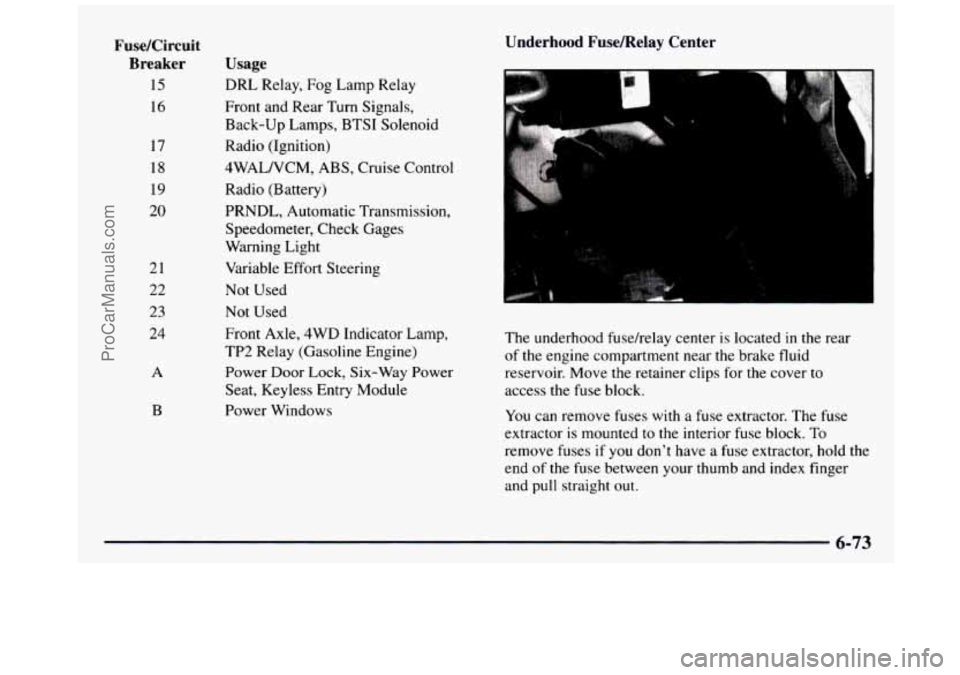
FuseKircuit Breaker
15
16
17
18
19
20
21
22
23
24
A
B
Usage
DRL Relay, Fog Lamp Relay
Front and Rear Turn Signals,
Back-up Lamps, BTSI Solenoid
Radio (Ignition)
LCWALNCM, ABS, Cruise Control
Radio (Battery)
PRNDL, Automatic Transmission, Speedometer, Check Gages
Warning Light
Variable Effort Steering
Not Used
Not Used
Front Axle, 4WD Indicator Lamp,
TP2 Relay (Gasoline Engine)
Power Door Lock, Six-Way Power
Seat, Keyless Entry Module
Power Windows
Underhood Fusemelay Center
The underhood fusehelay center is located in the rear
of the engine compartment near the brake fluid
reservoir. Move the retainer clips for the cover to
access the fuse block.
You can remove fuses with
a fuse extractor. The fuse
extractor
is mounted to the interior fuse block. To
remove fuses
if you don’t have a fuse extractor, hold the
end of the fuse between your thumb and index finger
and
pull straight out.
ProCarManuals.com
Page 350 of 436
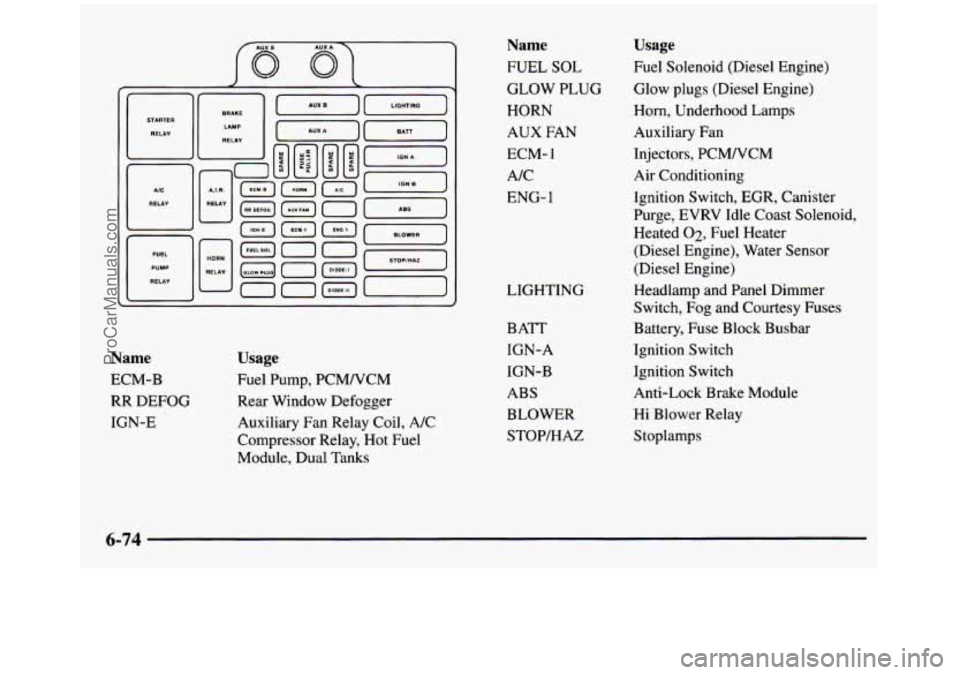
Name
ECM-B
RR DEFOG IGN-E
Usage
Fuel Pump, PCMNCM
Rear Window Defogger
Auxiliary Fan Relay Coil,
A/C
Compressor Relay, Hot Fuel
Module, Dual Tanks
Name
FUEL SOL
GLOW PLUG
HORN
AUX FAN
ECM-
1
NC
ENG-
1
LIGHTING
BATT
IGN-A
IGN-B ABS
BLOWER STOP/HAZ
Usage
Fuel Solenoid (Diesel Engine)
Glow plugs (Diesel Engine)
Horn, Underhood Lamps
Auxiliary Fan
Injectors,
PCMNCM
Air Conditioning
lgnition Switch,
EGR, Canister
Purge,
EVRV Idle Coast Solenoid,
Heated
02, Fuel Heater
(Diesel Engine), Water Sensor
(Diesel Engine)
Headlamp and Panel Dimmer
Switch,
Fog and Courtesy Fuses
Battery, Fuse Block Busbar
Ignition Switch
Ignition Switch
Anti-Lock Brake Module
Hi Blower Relay
Stoplamps
6-74
ProCarManuals.com
Page 352 of 436
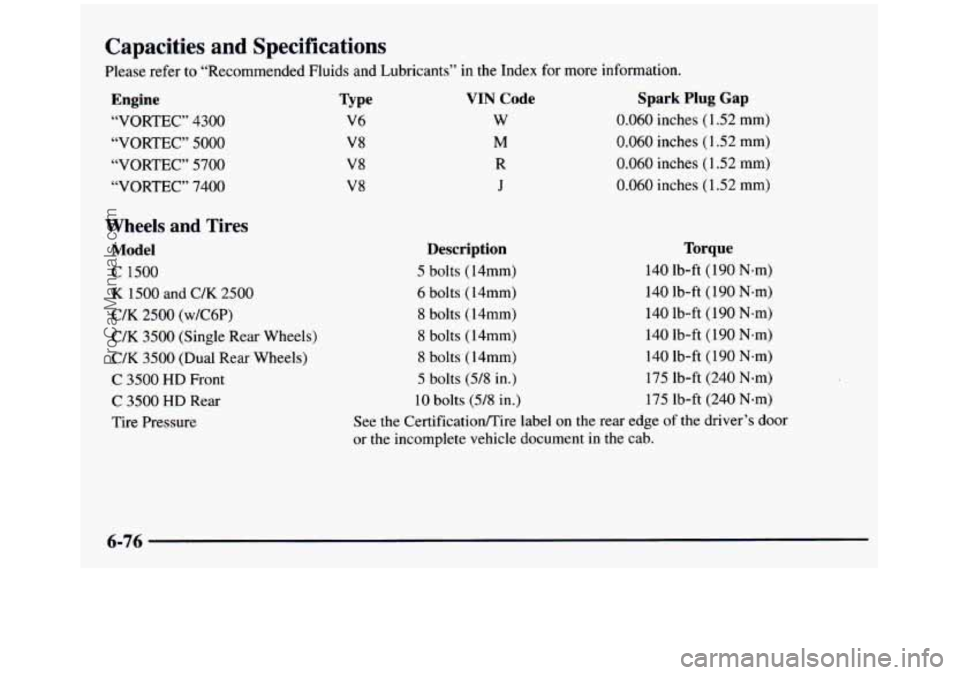
Capacities and Specifications
Please refer to “Recommended Fluids and Lubricants” in the Index for more information.
Engine Type VIN Code Spark Plug Gap
“VORTEC”
4300 V6 W 0.060 inches (1.52 mm)
“VORTEC” 5000 V8 M 0.060 inches (1.52 mm)
“VORTEC”
5700 V8 R 0.060 inches (1.52 mm)
“VORTEC” 7400
V8 J 0.060 inches (1.52 mm)
Wheels and Tires
Model
C 1500
K 1500 and C/K 2500
C/K 2500 (w/C6P)
C/K
3500 (Single Rear Wheels)
C/K 3500 (Dual Rear Wheels)
C 3500 HD Front
C 3500 HD Rear
Tire Pressure
Description Torque
5 bolts (14mm) 140 lb-ft (190 N-m)
6 bolts (14mm) 140 lb-ft ( 190 Nam)
8 bolts (14mm)
140 lb-ft ( 190 N-m)
8 bolts (14mm) 140 lb-ft ( 190 N-m)
8 bolts (14mm) 140 lb-ft ( 190 N-m)
5 bolts (5/8 in.) 175 lb-ft (240 N-m)
10 bolts (5/8 in.) 175
lb-ft (240 N-m)
See the CertificatiodTire label on the rear edge of the driver’s door
or the incomplete vehicle document
in the cab.
6-76
ProCarManuals.com
Page 354 of 436
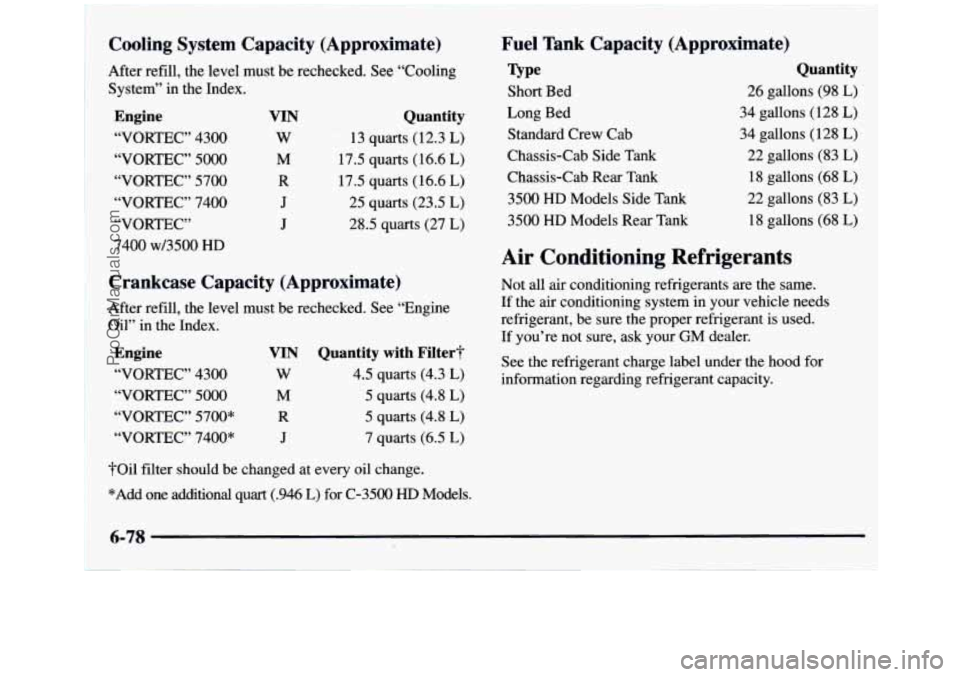
Fuel Tank Capacity (Approximate)
Type
Short Bed
Long Bed Standard Crew Cab
Chassis-Cab Side Tank
Chassis-Cab Rear Tank 3500
HD Models Side Tank
3500
HD Models Rear Tank
Cooling System Capacity (Approximate)
After refill, the level must be rechecked. See “Cooling
System” in the Index.
Engine
“VORTEC” 4300
“VORTEC”
5000
“VORTEC” 5700
“VORTEC” 7400
“VORTEC”
7400
w/3500 HD
VIN
W
M
R
J
J
Quantity
13 quarts (12.3 L)
17.5 quarts (16.6 L)
17.5 quarts (16.6 L)
25 quarts (23.5 L)
28.5 quarts (27 L)
Crankcase Capacity (Approximate)
After refill, the level must be rechecked. See “Engine
Oil” in the Index.
Engine
“VORTEC” 4300
“VORTEC”
5000
“VORTEC” 5700”
“VORTEC” 7400*
VIN
W
M
R
J
Quantity with Filter?
5 quarts (4.8 L)
5 quarts (4.8 L)
7 quarts (6.5 L)
4.5 quarts (4.3
L)
?Oil
filter should be changed at every oil change.
*Add one additional quart (.946
L) for C-3500 HD Models.
Quantity
26 gallons (98 L)
34 gallons (128 L)
34 gallons (128 L)
22 gallons (83 L)
18 gallons (68 L)
22 gallons (83 L)
18 gallons (68 L)
Air Conditioning Refrigerants
Not all air conditioning refrigerants are the same.
If the
air conditioning system in your vehicle needs
refrigerant, be sure the proper refrigerant
is used.
If you’re not sure, ask your GM dealer.
See the refrigerant charge label under the hood for
information regarding refrigerant capacity.
6-78
ProCarManuals.com
Page 356 of 436
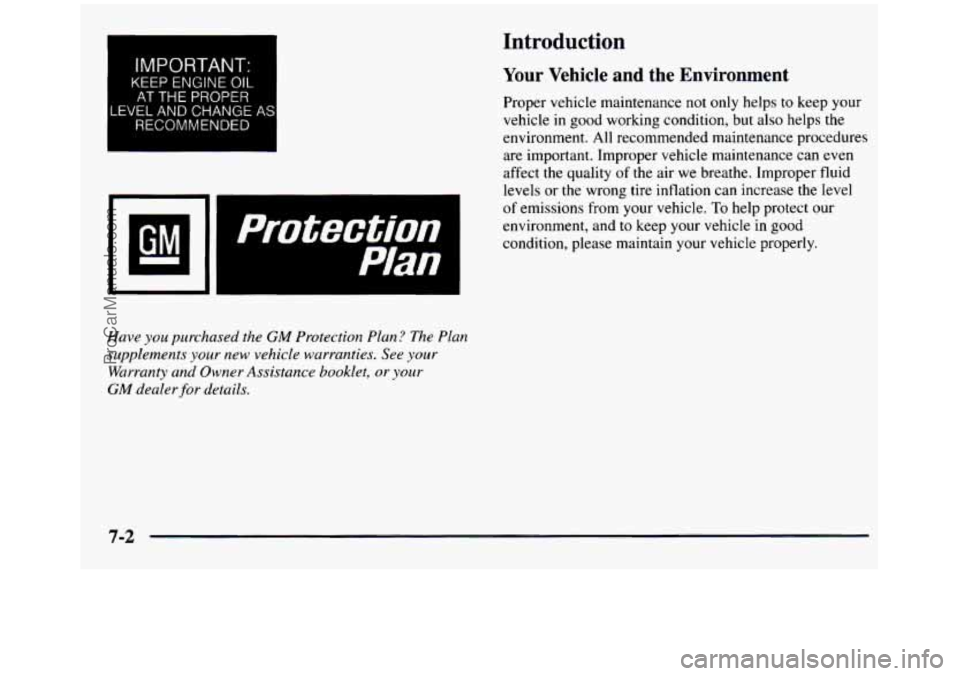
Introduction
IMPORTANT:
KEEP ENGINE OIL
AT THE PROPER
LEVEL AND CHANGE AS
RECOMMENDED
I
Your Vehicle and the Environment
Proper vehicle maintenance not only helps to keep your
vehicle
in good working condition, but also helps the
environment. All recommended maintenance procedures
are important. Improper vehicle maintenance can
even
affect the quality of the air we breathe. Improper fluid
levels or the wrong tire inflation can increase the level
of emissions from your vehicle. To help protect our
environment, and to keep your vehicle in good
condition, please maintain your vehicle properly.
Have you purchased the GM Protection Plan? The Plan
supplements
your new vehicle warranties. See your
Warranty and Owner Assistance booklet, or your
GM dealer for details.
7-2
ProCarManuals.com
Page 358 of 436

Part A: Scheduled Maintenance
Services
Using Your Maintenance Schedule
We at General Motors want to help you keep your vehicle
in good working condition. But we don’t know exactly
how you’ll drive it.
You may drive very short distances
only
a few times a week. Or you may drive long distances
all the time in
very hot, dusty weather. You may use your
vehicle
in making deliveries. Or you may drive it to work,
to do errands or
in many other ways.
Because of all the different ways people use their GM
vehicles, maintenance needs vary. You may even need
more frequent checks and replacements than you’ll find
in
the schedules in this section. So please read this
section and note how you drive. If you have any
questions
on how to keep your vehicle in good
condition, see your GM dealer.
This part tells you the maintenance services you should
have done and when you should schedule them. If you
go to your dealer for your service needs, you’ll know
that GM-trained and supported service people will
perform the work using genuine
GM parts.
The proper fluids
and lubricants to use are listed in Part D.
Make sure whoever services your vehicle uses these. All parts should
be replaced and all necessary repairs done
before you
or anyone else drives the vehicle.
These schedules are for vehicles that:
0
0
0
0
carry passengers and cargo within recommended
limits. You will find these limits on your vehicle’s
Certificatioflire label. See “Loading Your Vehicle”
in the Index.
are driven
on reasonable road surfaces within legal
driving limits.
are driven off-road in the recommended manner. See
“Off-Road Driving With Your Four-Wheel-Drive
Vehicle’’
in the Index.
use the recommended fuel. See “Fuel”
in the Index.
Selecting the Right Schedule
First you’ll need to decide which of the two schedules is
right for your vehicle. Here’s how to decide which
schedule to follow:
Gasoline engine vehicles and diesel engine vehicles
have different maintenance requirements. If you have a
diesel engine, follow
a schedule designated for diesel
engine vehicles only.
See the Diesel Engine Supplement for diesel engine
maintenance schedules.
7-4
ProCarManuals.com
Page 359 of 436

Maintenance Schedule
-
Short Trip/City Definition -- Gasoline Engines
Follow the Short TripKity Maintenance Schedule if any
one of these conditions is true for your vehicle:
Most trips are less than 5 to 10 miles (8 to 16 km).
This is particularly important when outside
temperatures
are below freezing.
driving in stop-and-go traffic).
off-road frequently.
Most trips include extensive idling (such as frequent
You operate your vehicle in dusty areas or
You frequently tow a trailer.
If the vehicle is used for delivery service, police, taxi
One of the reasons you should follow this schedule if you
operate
your vehicle under any of these conditions is that
these conditions cause engine
oil to break down soonel:
Short Trip/City Intervals -- Gasoline Engines
Every
3,000 Miles (5 000 km): Engine Oil and Filter
or other commercial application.
Change (or
3 months, whichever occurs first). Chassis
Lubrication (or
3 months, whichever occurs first). Drive
Axle Service (or
3 months, whichever occurs fmt).
Short Trip/City Intervals -- Gasoline Engines
Every 6,000 Miles (10
000 km): Tire Rotation.
Every 15,000 Miles (25 000 km): Shields and
Underhood Insulation Inspection (GVWR above
8,500 lbs. only). Front Wheel Bearing Repack (2WD
only) (or at each brake relining, whichever occurs first).
Every 30,000 Miles (50 000 km): Fuel Filter Replacement.
Every 50,000 Miles (83 000 km): Automatic
Transmission Service (vehicles over
8600 GVWR or
driven under severe conditions only).
Every 60,000 Miles (100 000 km): Engine Accessory
Drive Belt Inspection. Fuel Tank, Cap and Lines
Inspection. Exhaust Gas Recirculation System
Inspection. Evaporative Control System Inspection.
Every 100,000 Miles (166 000 km): Spark Plug Wire
Inspection. Spark Plug Replacement. Positive
Crankcase Ventilation (PCV) Valve Inspection.
Every 150,000 Miles (240 000 km): Cooling System
Service (or every
60 months, whichever occurs first).
These intervals only summarize maintenance services.
Be sure to follow the complete maintenance schedule
on the following pages.
ProCarManuals.com
Page 360 of 436
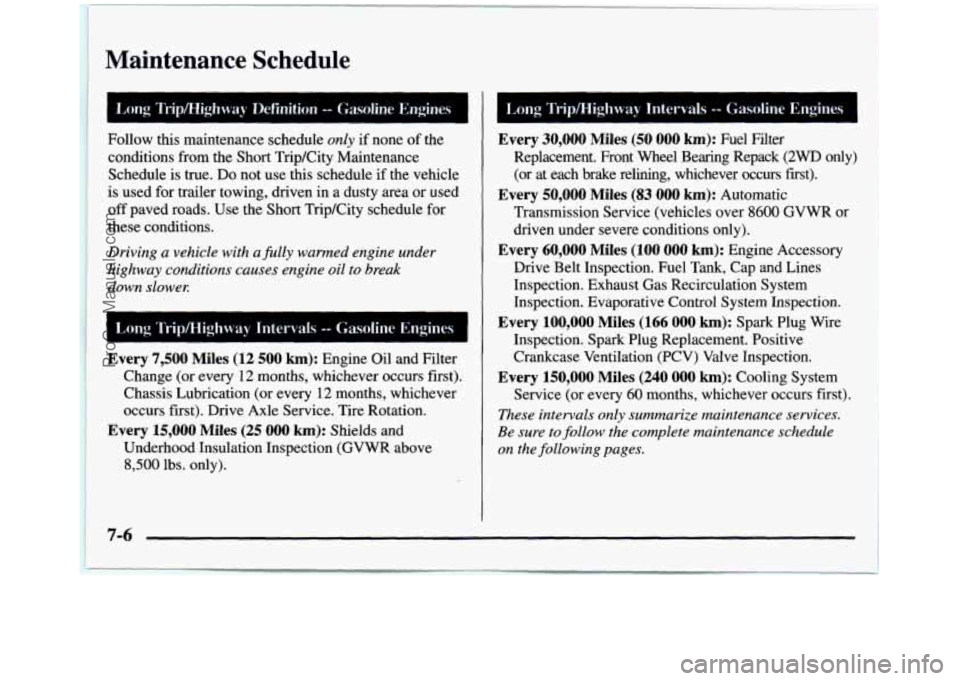
Maintenance Schedule
Follow this maintenance schedule only if none of the
conditions from the Short Trip/City Maintenance
Schedule is true.
Da not use this schedule if the vehicle
is used for trailer towing, driven in a dusty area or used
off paved roads. Use the Short Trip/City schedule for
these conditions.
Driving a vehicle with afully warmed engine under
highway conditions causes engine
oil to break
down slower:
Every 7,500 Miles (12 500 km): Engine Oil and Filter
Change (or every
12 months, whichever occurs first).
Chassis Lubrication (or every 12 months, whichever
occurs first). Drive Axle Service. Tire Rotation.
Underhood Insulation Inspection (GVWR above
8,500 lbs. only).
Every 15,000 Miles (25 OOO km): Shields and
I
1 Long Trip/Highway Intervals -- Gasoline Engines ~~~ ~
~ ~~
Every 30,000 Miles (50 000 km): Fuel Filter
Replacement. Front Wheel Bearing Repack
(2WD only)
(or at each brake relining, whichever occurs fiist).
Transmission Service (vehicles over
8600 GVWR or
driven under severe conditions only).
Every 60,000 Miles (100 000 km): Engine Accessory
Drive Belt Inspection. Fuel
Tank, Cap and Lines
Inspection. Exhaust Gas Recirculation System
Inspection. Evaporative Control System Inspection.
Every 100,000 Miles (166 000 km): Spark Plug Wire
Inspection. Spark Plug Replacement. Positive
Crankcase Ventilation (PCV) Valve Inspection.
Every 150,000 Miles (240 000 km): Cooling System
Service (or every
60 months, whichever occurs first).
Every 50,000 Miles (83 000 km): Automatic
These intervals only summarize maintenance services.
Be sure to
follow the complete maintenance schedule
on the following pages.
7-6
ProCarManuals.com